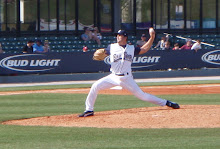
Much to do is made about the ball park in which a pitcher is pitching. Fenway in Boston is known for being a great place for lefties to pull the ball and righties to hit high towering balls over the monster. Yankee stadium, new or old, is notoriously easy to hit balls out of the yard. The left field line is only 314 ft. There are middle schoolers who can clear that distance. In Houston, the left field fence is so far forward that the left fielder has to adjust where he normally stands to adjust for how the ball will come off. The question becomes, though, does a pitcher need to adjust how he pitches based on the field in which he is playing. The quick answer is "no." That is to say, a pitcher should not alter the pitches he throws or how aggressive he is based on the stadium. Sure, the possibility exists that hitter could hit a less than towering drive and it might slip out of the park. However, that kind of happening cannot always be controlled. By altering what pitch you throw because of the park, a pitcher is more likely to loose his rhythm and his ability to put away a hitter once he is ahead. As I've said many times, a pitcher must always lean toward pitching to his strengths. If you have a "plus" fastball, then you want to stay with that pitch even if the hitter is a power guy.
That being said, making "adjustments' that play into your pitching strategy are always a plus. For example, focusing on locating pitches down in the zone is a strategy that is good for any pitcher to adopt. It also would serve the purpose of keeping balls in the yard more frequently. Pitching on both sides of the plate and changing speeds with all of your pitches are also great philosophies of pitching that also will help keep the hitter from squaring up pitches.
As we get more advanced, certain situations and hitters in the lineup can dictate pitches are thrown and when based on the pitcher. This requires a pitcher to be able to throw multiple pitches for strikes in any count. The situation could be when a number 3 hitter is at the dish with 2 outs. You don't necessarily want to challenge this guy inside early in the count. As a generally, staying away here to get ahead and get to a two strike count is a good idea. Similarly, if you have runners on first and third, with one out, using your ground ball pitch to get the double play is another way to pitch well in any park, not just a hitters park.
So let that be your guideline. If the philosophy matches up with overall good pitching strategies, then it is good to use to keep hitters in the park. Keep the ball down, change speeds, and attack the hitters!
Until Next Time!!

No comments:
Post a Comment